

Awesome Writing Anchor Charts to Use in Your Classroom. Anchor charts are a great way to make thinking visual as you teach the writing process to your students.
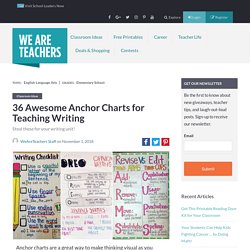
We searched high and low to find great anchor charts for all age levels. Here are some of our favorites. Hopefully they help you develop strong writers in your classroom. 1. Why Writers Write Source: The First Grade Parade. Classroom Dynamics: Practical tips on creating a successful group. The IH Andalucia conference was held last Saturday in Seville.
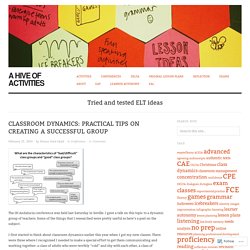
I gave a talk on this topic to a dynamic group of teachers. Some of the things that I researched were pretty useful so here’s a post on the subject. I first started to think about classroom dynamics earlier this year when I got my new classes. Peergrade. Build a tower, build a team! Life skills: Teamwork. – Get creative.
I have recently come across a very thought-provoking speech by Jack Ma, a world-famous businessman and…a former English teacher!

In the speech, he points out that today´s education system is far too knowledge based. He suggests that teachers should also focus on developing students´soft skills: teach values, believing, independent thinking, teamwork and care for others. “Everything we teach should be different from machines”, he goes on to say and personally, I couldn´t agree more. In the following lesson idea students will discuss the benefits of teamwork as well as reflect on their own team-building and communication skills. The second part of the lesson was inspired by Tom Wujec´s Marshmallow Challenge: First day activities – Get creative. Whether you like it or not, it´s time to go back to school!
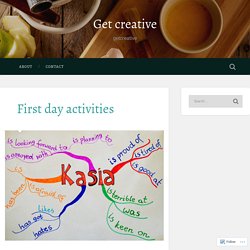
Here comes my personal favourite first day activity I have used over the years. Team Building Exercises - Problem Solving - from Mind Tools.com. © iStockphotoBluIz60 Encourage your people to throw themselves into team building activities. Whether there's a complex project looming or your team members just want to get better at dealing with day-to-day issues, your people can achieve much more when they solve problems and make decisions together.
By developing their problem-solving skills, you can improve their ability to get to the bottom of complex situations. Teaching Tips 5: Peer Editing & Correction. 20 Collaborative Learning Tips And Strategies For Teachers. 20 Collaborative Learning Tips And Strategies For Teachers by Miriam Clifford This post has been updated from a 2011 post.
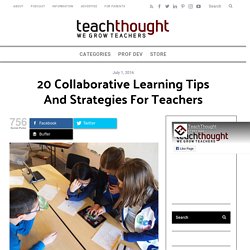
There is an age old adage that says “two heads are better than one”. Consider collaboration in recent history: Watson and Crick or Page and Brin (Founders of Google). But did you know it was a collaborative Computer Club about basic programming at a middle school that brought together two minds that would change the future of computing? Yes, those two were of course Bill Gates and Paul Allen, the founders of Microsoft. Collab web. The Collaborative Classroom. M.B.

Tinzmann, B.F. Jones, T.F. Fennimore, J. Bakker, C. Fine, and J. Edutopia. Establish Group Agreements. Teaching Strategy: Save the Last Word for Me. 20 Collaborative Learning Tips And Strategies For Teachers. Edutopia. Collaborative learning blog. How to use real problems to spark real engagement. 26 Sentence Stems For Higher-Level Discussion In The Classroom. 26 Sentence Stems For Higher-Level Conversation In The Classroom by Terry Heick Meaningful conversation can make learning more personal, immediate, and emotional.
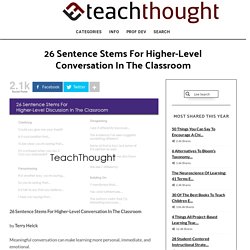
During meaningful conversations, students are forced to be accountable for their positions, to listen, to analyze opposing perspectives, and to adapt their thinking on the fly. There are many popular strategies for these kinds of conversations, each with slightly unique rules and applications. Among them are Socrative Discussions, Accountable Talks, Debate, and Literature Circles. 5 useful ways to kick-start student collaboration in the classroom.
My five-year-old son has become obsessed with Bill Nye (you know, the science guy).
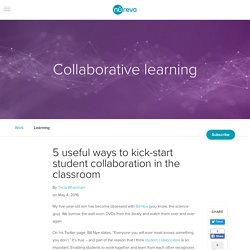
We borrow the well-worn DVDs from the library and watch them over and over again. On his Twitter page, Bill Nye states, “Everyone you will ever meet knows something you don’t.” It’s true – and part of the reason that I think student collaboration is so important. Enabling students to work together and learn from each other recognizes that teachers don’t have all the answers – because no individual does. In our global community, that’s true now more than ever.
But delivering on the promise of student collaboration in the classroom isn’t easy. 1. 4 Methods to Enhance Student Collaboration in the Classroom. Teachers are continually looking for ways to enhance student collaboration in the classroom.
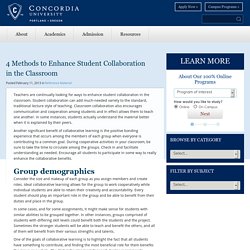
Student collaboration can add much-needed variety to the standard, traditional lecture style of teaching. Classroom collaboration also encourages communication and cooperation among students and in effect allows them to teach one another. In some instances, students actually understand the material better when it is explained by their peers. Another significant benefit of collaborative learning is the positive bonding experience that occurs among the members of each group when everyone is contributing to a common goal. During cooperative activities in your classroom, be sure to take the time to circulate among the groups. 6 Questions Students Can Use To Guide Their Inquiry-Based Learning - 6 Questions Students Can Use To Guide Their Inquiry-Based Learning by Ashley McCann Learning through inquiry is one of the most ‘natural’ and organic forms of learning.
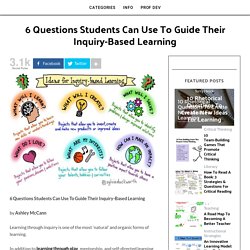
4 Methods to Enhance Student Collaboration in the Classroom. Team building and collaboration: Up for a Challenge? – On the same page. Perhaps one of the best team-building activities I know is the popular marshmallow challenge, perfect for a time when we are still setting up the ground rules that will define that learner-centred, interactive and cooperative learning environment we will be working in for the next few months. Although initially created as a design challenge for the corporate world, the task can easily be adapted to a language learning setting in which the students will practise all four skills while completing the challenge, and learn compelling lessons on collaboration that they will hopefully apply to their daily classroom practice for the rest of the year.
After asking the students to define “collaboration” and think about what it takes to collaborate effectively, draw their attention to the importance of appropriate language use in the process and how ideas should be exchanged within a cooperative setting. Working Together.pdf.